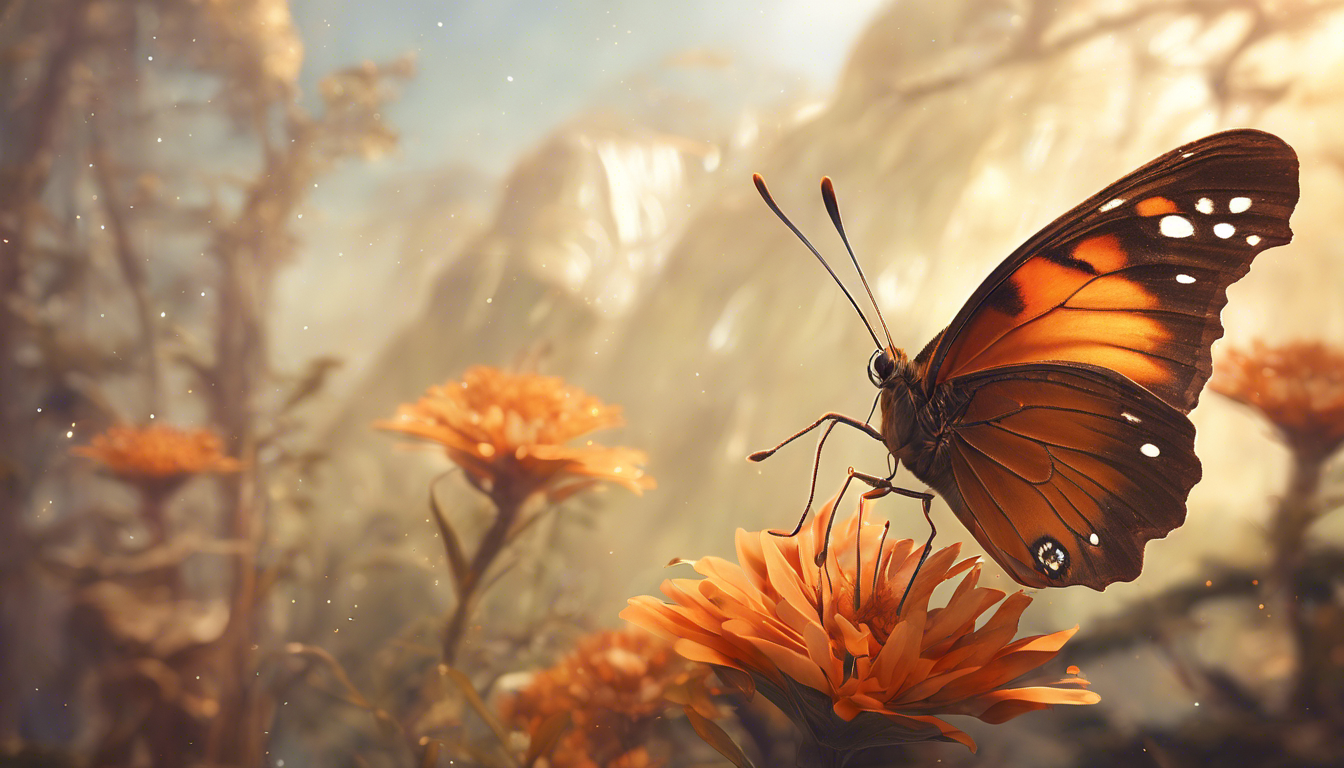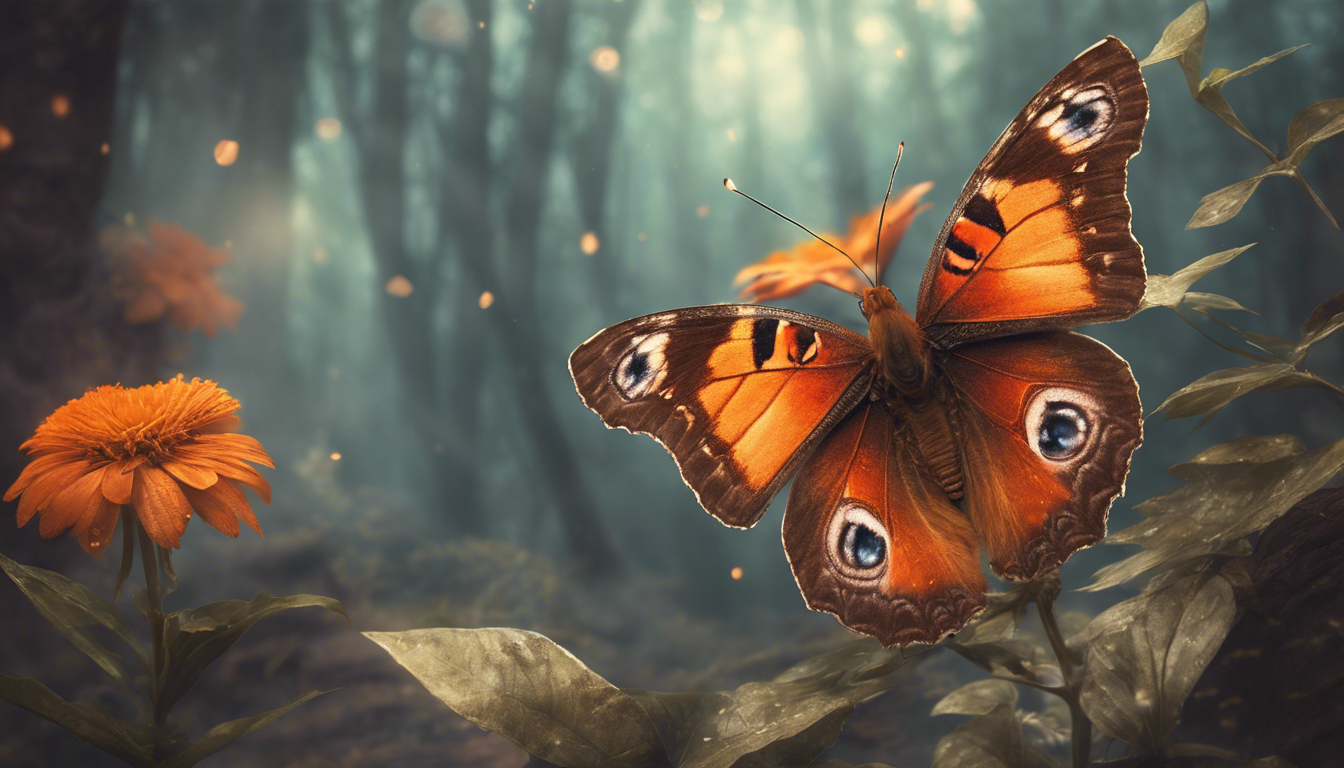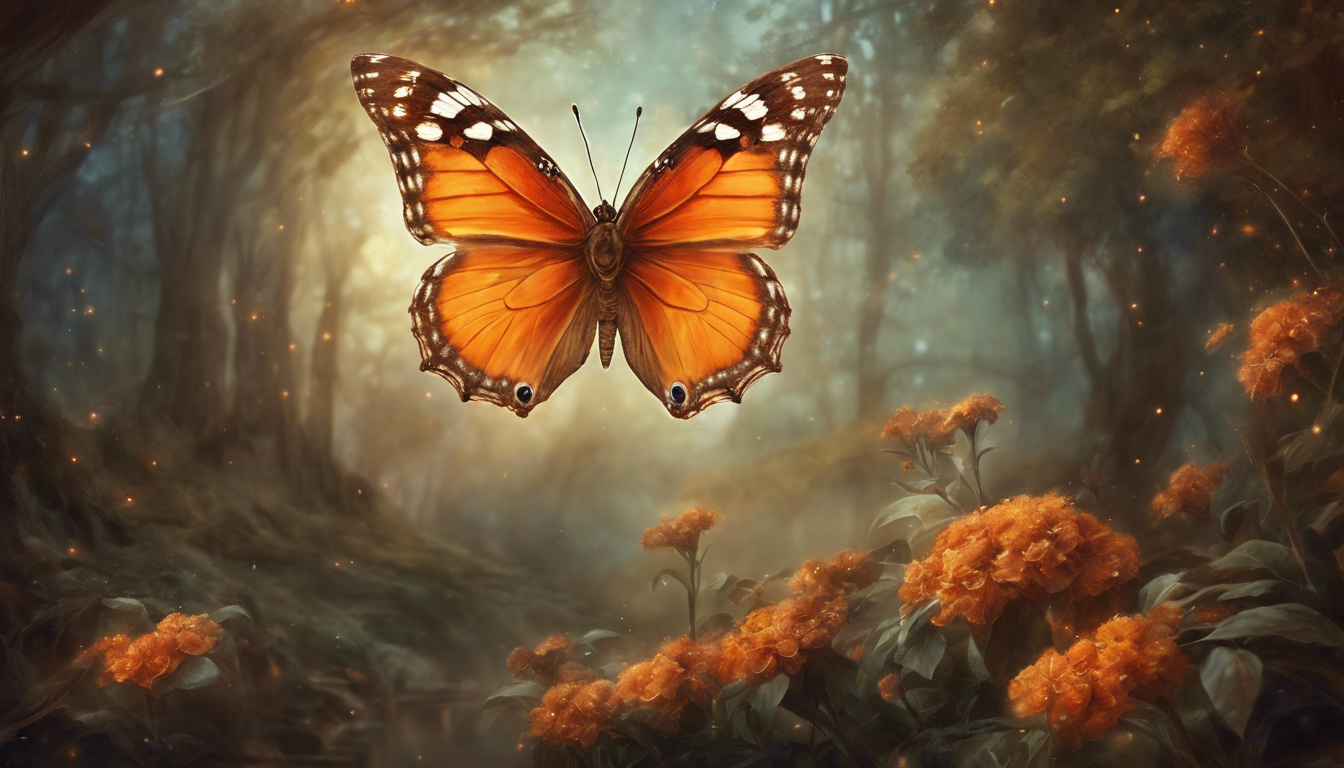Brown and orange butterflies hold a special significance in nature, symbolizing transformation, courage, and creativity. Let’s explore the mysterious beauty and spiritual meaning behind these enchanting creatures.
The unique colors and patterns of brown and orange butterflies

Butterflies are some of the most colorful and visually stunning creatures in the insect world. Among the myriad of butterfly species, those with brown and orange hues exhibit a particularly striking beauty that captivates onlookers. The unique colors and patterns seen in brown and orange butterflies add to their allure, making them a fascinating subject of study and admiration.
the diversity of brown and orange butterflies
Brown and orange butterflies come in a wide array of species, each with its distinct shades, markings, and patterns. Some species showcase a uniform brown or orange color, while others feature intricate patterns and designs that make them stand out in their natural habitats. The diversity in colors and patterns among brown and orange butterflies reflects the richness of nature’s palette and the amazing adaptability of these creatures.
brown and orange butterfly patterns
When examining brown and orange butterflies, one cannot help but marvel at the intricate patterns adorning their wings. These patterns serve various purposes, including camouflage, mating displays, and warning signals to predators. The patterns on brown and orange butterflies can range from delicate swirls and lines to bold spots and stripes, showcasing the endless creativity of nature in designing these mesmerizing creatures.
the significance of coloration in butterflies
The colors exhibited by butterflies, including brown and orange hues, play essential roles in their survival and reproductive success. Brown and orange colors can help butterflies blend in with their surroundings, evade predators, and attract potential mates. Understanding the significance of coloration in butterflies sheds light on their evolutionary adaptations and ecological interactions.
appreciating nature’s artistry
When observing brown and orange butterflies in their natural habitats, one cannot help but appreciate the artistry and beauty present in these creatures. From the intricate patterns on their wings to the way they flutter gracefully in the air, brown and orange butterflies exemplify nature’s exquisite craftsmanship and elegance. Taking the time to admire and study these butterflies allows us to connect with the natural world and marvel at its wonders.
In conclusion, brown and orange butterflies stand out for their unique colors and patterns, showcasing the beauty and diversity of the butterfly kingdom. By exploring the intricacies of their coloration and designs, we gain a deeper appreciation for these captivating insects and the awe-inspiring world they inhabit.
The role of mimicry in survival for brown and orange butterflies

Butterflies, with their graceful beauty and delicate wings, have long fascinated nature enthusiasts and scientists alike. Among the various species of butterflies, the brown and orange butterflies stand out not only for their striking colors but also for their survival tactics. In this article, we explore the fascinating role of mimicry in the survival of brown and orange butterflies.
protective mimicry: blending in to survive
Mimicry plays a crucial role in the survival of brown and orange butterflies. By mimicking the colors, patterns, or behaviors of other organisms in their environment, these butterflies can camouflage themselves and avoid predators. Brown and orange butterflies often mimic leaves, tree bark, or even toxic species to deter predators.
Brown butterflies, such as the well-known Camouflage Butterfly, utilize mimicry to blend seamlessly into their surroundings. Their dull brown hues and patterns resemble dried leaves, making them almost invisible when resting on tree trunks or the forest floor.
Orange butterflies, like the Monarch Butterfly, take advantage of their vibrant coloration to warn predators of their toxicity. Through aposematic mimicry, other orange butterflies mimic the Monarch’s pattern to ward off predators, signaling danger with their bright orange wings.
aggressive mimicry: deceiving for survival
While protective mimicry helps butterflies avoid predation, aggressive mimicry is another survival strategy employed by some species. This tactic involves deceiving other organisms to gain an advantage, such as luring prey or avoiding detection by predators.
Some brown and orange butterflies, like the Owlfly Butterfly, use aggressive mimicry to imitate predators or harmful insects. By resembling these threats, they can deter potential predators or prey, enhancing their chances of survival in their habitats.
symbiotic relationships: mutual benefits through mimicry
In addition to protective and aggressive mimicry, some brown and orange butterflies engage in symbiotic relationships with other species for mutual benefits. Mutualistic mimicry involves two or more species benefiting from mimicking each other, often to enhance their survival rates.
One example of symbiotic mimicry is the relationship between certain brown butterflies and ants. These butterflies produce chemical cues that mimic those of ant colonies, gaining protection from predators that are deterred by the presence of ants. In return, the ants may receive benefits such as nutrients or protection from other predators.
Butterflies, particularly brown and orange species, demonstrate the remarkable adaptations and survival strategies that mimicry offers in the natural world. Whether through protective mimicry, aggressive mimicry, or symbiotic relationships, these butterflies have evolved to thrive in diverse environments. By understanding the role of mimicry in their survival, we gain insight into the complex and intricate ways in which these beautiful insects navigate their ecosystems.
The importance of pollination in the ecosystem

Butterflies as Pollinators
Butterflies play a crucial role in pollination within various ecosystems. As they flutter from flower to flower in search of nectar, they inadvertently transfer pollen grains, aiding in the process of fertilization. This unique relationship between butterflies and plants is essential for the reproduction and survival of many species.
The Role of Butterfly Pollination
Butterfly pollination contributes significantly to the biodiversity and health of ecosystems. Pollination is essential for the production of fruits, seeds, and the perpetuation of plant species. Butterflies, with their delicate yet efficient pollination techniques, are key players in maintaining the balance of various ecosystems.
Impact on Plant Diversity
The importance of butterfly pollination can be observed in the diverse range of plants that rely on these insects for pollination. From wildflowers to agricultural crops, butterflies contribute to the reproduction of a wide array of plant species, promoting biodiversity and ecosystem resilience.
Conservation Efforts
Given the critical role of butterflies in pollination, conservation efforts aimed at protecting these insects are essential. Habitat preservation, planting native flower species, and reducing pesticide use are some of the strategies that can support butterfly populations and ensure continued pollination services in ecosystems.
Butterfly pollination is a vital component of the ecosystem, sustaining plant diversity and ecosystem health. By recognizing the importance of butterflies as pollinators and implementing conservation measures to protect them, we can safeguard the intricate web of life that relies on their essential role in pollination.
The symbiotic relationships between butterflies and plants
Butterflies and plants have a fascinating relationship that goes beyond mere pollination. This symbiotic connection plays a crucial role in the ecosystem, benefiting both parties involved. Let’s delve into the intricate dance of butterflies and plants, and the harmony they create in nature.
pollination by butterflies
Butterflies are not only admired for their graceful flight and vibrant colors but also for their essential role as pollinators. As they flutter from flower to flower in search of nectar, butterflies inadvertently transfer pollen grains, facilitating the reproduction of various plant species. This process is vital for the biodiversity and survival of many plant communities.
benefits for butterflies
For butterflies, plants are more than just a food source; they also provide shelter and breeding grounds. Caterpillars, the larval stage of butterflies, often rely on specific plants as host species to feed and develop. This specialized relationship highlights the coevolution between butterflies and plants, where each has adapted to benefit the other.
diversity in plant adaptations
Plants have evolved a myriad of adaptations to attract butterflies, ensuring successful pollination. Some plants produce nectar-rich flowers with bright colors and intricate shapes to lure butterflies. Others emit pheromones that specifically attract certain butterfly species. This diversity in plant strategies highlights the coevolutionary arms race between plants and butterflies.
threats to the symbiosis
Despite the mutual benefits of the relationship between butterflies and plants, various factors pose a threat to this delicate balance. Habitat loss, climate change, and pesticide use are among the challenges that can disrupt the symbiotic interactions between butterflies and plants. Conservation efforts are crucial to safeguard the diversity and resilience of these interconnected ecosystems.
The intricate web of symbiotic relationships between butterflies and plants showcases the beauty and complexity of nature’s interconnectedness. By understanding and preserving these delicate balances, we can ensure the continued survival and flourishing of both butterflies and plants in our ecosystems.
The impact of habitat loss on brown and orange butterfly populations
habitat loss is a critical issue facing butterfly populations worldwide. this problem is particularly affecting brown and orange butterfly species, leading to a decline in their numbers and threatening their survival.
the importance of habitat for brown and orange butterflies
for butterflies, their habitat is more than just a place to live; it provides essential resources for their survival and reproduction. habitat loss directly impacts their ability to find food, shelter, and suitable breeding grounds. brown and orange butterflies, in particular, rely on specific plants for nectar and host plants for their caterpillars.
factors contributing to habitat loss
several factors contribute to habitat loss for brown and orange butterflies:
- urbanization: as cities expand, natural habitats are destroyed or fragmented, limiting the available space for butterflies.
- deforestation: clearing of forests eliminates crucial butterfly habitats, disrupting their life cycle.
- agricultural practices: the use of pesticides and monocultures reduces the diversity of plants butterflies depend on.
consequences of habitat loss on brown and orange butterfly populations
the impact of habitat loss on brown and orange butterfly populations is severe:
- population decline: diminished habitats lead to fewer butterflies and, in some cases, local extinctions.
- genetic isolation: fragmented habitats can isolate butterfly populations, leading to genetic bottlenecks and reduced diversity.
- increased competition: as suitable habitats shrink, butterflies must compete for limited resources, further endangering their populations.
ways to conserve brown and orange butterfly habitats
to protect brown and orange butterfly populations, it is crucial to:
- preserve natural habitats: safeguarding existing butterfly habitats is essential to maintaining their populations.
- plant native species: creating butterfly-friendly gardens with native plants can provide additional resources for butterflies.
- reduce pesticide use: minimizing the use of pesticides in agricultural areas near butterfly habitats can help prevent their decline.
by addressing the challenges of habitat loss, we can work towards ensuring a brighter future for brown and orange butterfly populations.


Article written by Dera
Greetings, I am Dera, a 35-year-old individual with a deep passion for spirituality. Through my website, I aim to share my insights and knowledge to help others on their spiritual journey. Join me on the path to inner peace and enlightenment.